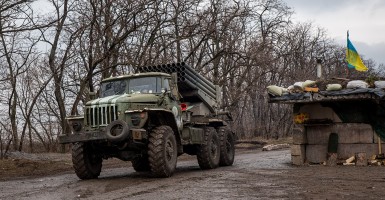KYIV, Ukraine—As the Ukraine cease-fire goes into its second month, international monitors say the fragile truce is still holding despite daily fighting and growing distrust on both sides about pledges to pull heavy weapons from the front lines.
Speaking to reporters here Thursday, Alexander Hug, deputy chief monitor of the Organization for Security and Cooperation in Europe (OSCE) Special Monitoring Mission in Ukraine, discussed the status of the 1-month-old cease-fire.
“The OSCE deems that the cease-fire holds broadly,” Hug said. “But this relative stability is on thin ice.”
While both sides appeared to have pulled their heavy weapons back from the front lines and the number of serious cease-fire violations has declined, fighting continues across the conflict area.
Ukraine said pro-Russian separatists violated the cease-fire 50 times in a 24-hour period beginning Wednesday in a wave of attacks across the country’s eastern territories. Military spokesperson Andriy Lysenko said no Ukrainian troops were killed or injured in the attacks.
Wednesday’s attacks underscored the fragility of the truce, which was signed Feb. 12 in the Belarusian capital of Minsk.
“Separatists continue to shell Ukrainian positions in brutal violation of the cease-fire agreement,” Ukrainian military spokesman Anatoliy Stelmakh said Thursday.
A previous cease-fire, signed Sept. 5, 2014, collapsed earlier this year. While the current cease-fire has largely stalled the conflict’s escalation, it got off to a rocky start.
Days after the deal went into effect on Feb. 15, pro-Russian separatists sacked the eastern Ukrainian town of Debaltseve, a strategic railway hub then held by Ukrainian troops.
Separatists eventually took the town, forcing roughly 2,000 Ukrainian troops into a chaotic retreat.
While the intensity of the fighting has declined since the Debaltseve siege, attacks occur daily along the 500-kilometer-long front line in the Donbas.
The heaviest fighting since the Debaltseve siege has taken place in the rebel stronghold of Donetsk and in areas outside the industrial port city Mariupol on the Sea of Azov.
Hug acknowledged the number of cease-fire violations was troubling, but pointed to the increasing prevalence of small arms attacks over artillery strikes as evidence that both sides were at least nominally adhering to the cease-fire by limiting their use of heavy weapons.
“In general it is positive that most of the fighting is conducted by small arms fire, indicating most heavy weapons have been withdrawn,” he said.
In addition to the continued fighting, another lingering quesion is whether both sides actually withdrew their heavy weapons from the front lines or stashed them in nearby factories and coal mines where they remain hidden from inspectors but are still quickly available.
When asked if Ukrainian forces had withdrawn heavy weapons according to the cease-fire terms, Lysenko said: “The main task for us is to not miss a probable attack by the enemy and to adequately respond to any enemy attack. The situation with monitoring the other side is quite problematic.”
Both Ukrainian and separatist forces have interfered with the free movement of OSCE monitors looking for hidden heavy weapons in the conflict zone, Hug said, adding that he had already discussed the issue with Ukrainian officials.
“All sides need to know that the weapons have not only been withdrawn, but remain withdrawn,” Hug said. “More needs to be done to verify the weapons stay off the front lines. And the OSCE mission needs freedom of movement.”

Alexander Hug, deputy chief monitor of the Organization for Security and Cooperation in Europe (OSCE) Special Monitoring Mission in Ukraine, speaks to journalists Thursday in Kyiv. (Courtesy Ukraine Crisis Media Center)
The OSCE currently has 460 monitors from 42 participating countries deployed to 10 locations throughout Ukraine to monitor the execution of the cease-fire.
Last year OSCE monitors began using drones, which independent military contractors provided, to monitor the Ukraine-Russia border for arms shipments and troop movements from Russia into Ukraine.
While the OSCE has appealed to member nations for the use of satellite and drone surveillance technology to monitor the cease-fire, Hug said there is no substitute for teams on the ground.
“These technologies will help but we need unhindered ground access,” Hug said. “A satellite cannot look into a factory, and a drone cannot look into a coal mine.”
Wednesday’s wave of attacks follows U.S. and NATO statements this week condemning Moscow for continuing to arm the separatists in violation of the cease-fire.
At a hearing before the U.S. Senate Foreign Relations Committee on March 10, Assistant Secretary of State for European Affairs Victoria Nuland accused Russia of violating the cease-fire by sending weapons across the border into Ukraine.
“We can confirm new transfers of Russian tanks, armored vehicles, heavy artillery, and rocket equipment over the border to the separatists in eastern Ukraine,” Nuland said.
The Kremlin has denied providing material support or weapons to the separatists and has accused Kyiv of violating the truce.
“Full implementation of the Minsk agreements is essentially being blocked by the Kyiv authorities,” Russian Foreign Minister Sergei Lavrov said March 10, according to Voice of America.
According to the United Nations, the conflict in Ukraine has killed more than 6,000 civilians and military personnel and displaced more than 1 million people.































